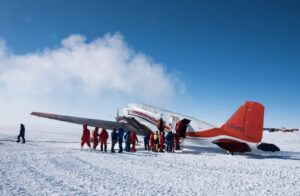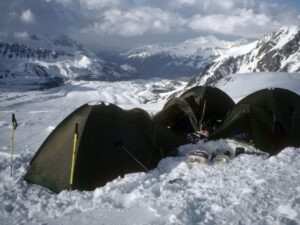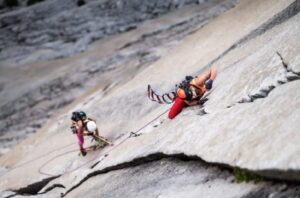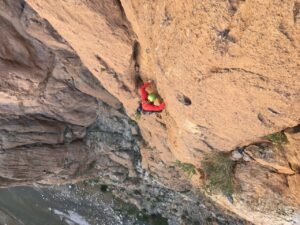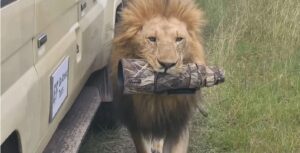Confusion, buzz and bustle! M&M check in from the Dakar Rally 2017 compound in La Paz, Bolivia.
Wheelchair at the Dakar Rally
Confusion, buzz and bustle! Scheduled that Sunday, it wouldn’t be a relaxing day at the Dakar Rally 2017 noted Michal Woroch, pulling into Dakar’s compound in his wheelchair.
His team mate of the “Wheelchair Trip” expedition, Maciej Kaminski, suffered temporary food poisoning and couldn’t visit with the racers, or meet with Rafal Sonik, a Polish quad rally driver who has won the Dakar Rally once before.
– I’m impressed that Mr. Sonik, though very busy and tired, found time to talk with me – reports Michal.
– I also got opportunity to watch all the people involved in the organization and running of the rally. It was a very interesting experience.
Michal and Maciek reached La Paz, capital of Bolivia, where coincidently “Dakar Town” is located, after 7 weeks of travel, starting from Buenos Aires in Argentina.
In their 21-year old Land Rover Defender, called “the beloved Home Defe” they have covered more than 7,500 miles, first heading south to Tierra del Fuego then along the Pacific coast to the north, in the direction of the Atacama Desert and the Andean Altiplano plateau.
Not even halfway through the “Wheelchair Trip” expedition, the two disabled travelers want to prove that some physical limitations can be overcome by the power of determination, patience and friendship, and that those impossible obstacles can be defeated by accepting them. More about that later!
Easy beginnings ….
There were problems at the start. Defe, which for Michal and Maciek had to be a means of transportation and also a base, a bedroom, a kitchen, and an atelier, in short, everything they need to travel, was detained at the customs office at the port of Buenos Aires.
Thanks to the intervention of the Polish Embassy in Argentina, custody of the vehicle did not last too long, just four days. During that time, Michal and Maciej managed to win the sympathy of Polish diplomats and a Polish priest, Father Jerzy, as well as their hosts, the Albertan sisters. Also, Kasia, a Polish woman who rode with them in the final part of her trip around the world.
These two young men, from whom disease had taken away the freedom of movement, but not the pursuit of dreams, impressed everyone without exception.
Facing extensive, open and very windy areas of eastern Patagonia, they reached the sun-drenched Tierra del Fuego at the tip of South America, Ushuaia.
From there, along the ranches of the Andes, passing the Argentina and Buenos Aires Lakes, and glaciers shining in the distance, they drove parallel with the west coast of the continent to Chile.
The unique charm of the area was highlighted by a long stretch of hundreds of fjords. Already in the territory of Chile, the trail between the volcanoes was leading to Punta Arena, located at sea level, where the flat wilderness, devoid of vegetation, becomes a fertile oasis, filled with greenery.
They stopped briefly in Santiago, where the Polish Embassy welcomed them with family warmth. Then, admiring from one side the chain of snow-capped Andes in the distance, and at the other side, the Pacific Ocean with its glistening turquoise waves lapping on the rocky coast, they came to Antofagasta, a city that seems to be an oasis in the desert of Atacama.
– It was supposed to be so difficult, and it is not! – Laughed Michal. In Antofagasta, a Polish priest, father Marcin, who read on Facebook about the expedition, invited the two friends to visit him. What is more, he surprised them with a great fish dinner and checked them in at the best hotel in town with a room overlooking the ocean. This was a perfect Christmas gift, because it happened to be Christmas Eve.
– Not only holidays came together with kindness from the locals. Often, we see interest in the local people’s eyes, sometimes even surprise, when we draw our two wheelchairs out of the vehicle and move around in them, and people are so good, says Michal.
They are asked about the destination, and receive words of encouragement and belief in the success of their plan. And if someone is not convinced right away, it certainly helps when the two friends present him or her with the picture of Pope John Paul II.
– It seems that our Pope is also recognized as theirs. John Paul II is still very well respected here and considered a friend of the people. He was Polish and we are Polish – it works!
Father Marcin from Antofagasta helped to replenish the inventory of images of Polish Pope,. There should be enough of them until travelers reach Washington, DC.
Sand, salt and stones ….
Antofagasta is the gateway to the Atacama Desert, a sand-covered plateau captivating a collection of colors of red, orange and yellow. And unlike most dry places on Earth, since measurements have ever been recorded, there had not even been an inch of rainfall.
– This place reminds me of the planet Mars, even though I have never been there – says Maciej – Lots of shades of red and yellow, and a completely deserted horizon.
In keeping with astronomical analogies, the Atacama Desert indeed looked like the landscape of Mars, dominated by a distinctive red color; but it also could be described as the lunar landscape. Flat, empty spaces sometimes varied elevation, sandy places alternating with dried and cracked ground and an evaporating saline environment with whitish coating. No vegetation, except lichens and thorny shrubs, just the heat, dry air, and sun.
Nevertheless, for Michal it was one of the most beautiful places on Earth, with the stunning play of colors and lights. Fascinating, yet terrifying emptiness and isolation from the outside world. And yet it was a great practice ground for driving the car!
– Driving a car in this area was a real challenge, and for us a new experience – said Michal.
– In the area of National Park Atacama Desert we drove 130 miles on a very difficult road; sometimes it felt like being on a grater, or wavy layers of sand with grooves made by other vehicles between which, we had to maneuver carefully so as not to damage the car, and moments later the stones bouncing off the road were hitting the chassis. Under those conditions, it would have been so easy to damage the car.
Defe was not damaged, but the travelers came to the conclusion that in La Paz it would be necessary to strengthen the springs and replace the rubber suspension components in order to be prepared for another difficult route.
If something is impossible, we laugh it off
Defe, their home on wheels, is a window to the world because often only through its windows can they admire views outside. Sometimes unavailable to them due to difficulty of maneuvering the wheelchairs over the rough terrain.
One day, Michal and Maciej decided to visit the reserve of flamingos at the Atacama. Flamingos are one of the few species of birds living in the desert, and they became a symbol of this extraordinary place. They are not bright pink, like those seen in the pictures, but slightly faded by the salt floating in the air.
After the travelers stopped the car in the designated parking lot, it turned out that to see the flamingos they would still have to go a long way including a portion of rocky road.
– It would have taken us a lot of time and energy. I would have to hold to Maciej and he would have to put twice as much effort to move his and my wheelchair – explained Michal.
– It happens so often on our trip that we see someone easily walking in the area while for us to get around it would be much more difficult.
Michal and Maciej’s stories have made me realize how much more time and effort must be put into action compared to that which a freely moving person would just take a few seconds to do. In their case, lots of patience, peace, and determination are usually needed to accomplish simple tasks.
For example, fetching the phone charger left in the back seat of the car can translate into a laborious procedure. It is not just turning back to reach it or walking a few steps. In their case it is an operation involving removing both wheelchairs from the car using one lift, then another elevator, which is used for transportation of the chairs to the roof of the car, and then moving inch by inch into the back of the car to grab that forgotten cable.
If something like that happens, it is obvious to us that the phones simply will not be charged at that moment in time.
– A rule is that we dismiss such situations with laughter!
If something cannot be done, or it is too difficult to do, we just laugh. We are not going to cry, because we did not see the flamingos – says Maciej.
– Although I admit, there were two or three occasions when we did not feel like laughing.
On the Altiplano
They stopped laughing at the altitude of over 14,500 ft. above sea level.
From Atacama at around 6,600 ft. they entered the Altiplano Plateau in the Andes and began to climb up, heading for La Paz. Some 2,000 ft. higher they stopped for a brief acclimatization, moved on, and only a few dozen miles up the steep road they found themselves very quickly at an altitude of nearly 16,500 ft. Headaches hit immediately.
– I think probably, we felt too comfortable in the first part of the climb and didn’t give ourselves enough time to acclimatize. We felt well enough at 11,500 ft. and didn’t think another 3,300 to 5,000 ft. would make too much difference with regards to oxygen in the air.
I admit that I got scared when I started to feel numbness in my fingers. I thought it was because I had clutched my hands tightly on the steering wheel while driving for a long time. After we stopped, within a few minutes my hands got cramped and disfigured. I was so afraid to tell Michal – Maciej recalls his experience.
Fortunately, after about ten minutes his hands were back to normal.
Michal and Maciej left Santiago, Chile with two oxygen tanks, which I was able to obtain with help of my friends so, if necessary, they are applying a 10-minute session to oxygenate their bodies and help to overcome adverse conditions. However, the high altitude still affects the wellbeing of both travelers, causing sluggishness and drowsiness. They even slept through the New Year by Salar de Uyuni, slightly intoxicated with “one-inch” dose of whiskey,.
Addicted to travel
When they reached La Paz, the highest above-sea level capital in the world, Michal ignored oxygen deprivation and embarked on one of his usual “motor” trips around town.
Just before leaving Poland, he had constructed a device that attaches under his wheelchair and allows him to drive at speeds up to 25 mph.
– The device helps me to be much more mobile although I may have overdone it with the battery – it has a range of 75 miles – comments Michal.
In the past, Michal used to spend long hours riding a regular bike. These days his invention, lovingly called my little bike, allows him to pursue his greatest passion: Exploring every corner of the sites and towns he visits, watching people, and discovering the world.
He enjoys watching the towns and cities wake up in the morning, as the markets open, and traders arrange fresh fruits and vegetables on their stands. He observes the increasing buzz and noise, how cars run through the intersections, how the ocean looks from above.
Reaching places on his own, wandering the streets and alleyways seems to give him a sense of freedom, independence, full authority and control over his ability to move around.
– I love traveling, and even if I don’t feel my best, I will not give it up until I have to – he said.
Shortly after the enjoyable visit to the Dakar 2017 Compound and meeting with Rafal Sonik, Michal and Maciej set out from La Paz, to continue on their trip, heading toward Peru.
Piotr Chmielinski
Washington,
January 12, 2017
Additionally, check previous stories:
https://explorersweb.com/South-America-on-double-four-wheels-2016-11-01-58629
https://explorersweb.com/Wheelchair-Trip-in-Ushuaia-2016-12-04-9979
https://explorersweb.com/Wheelchair-Trip-in-National-Geographic-2016-11-28-52843
and https://www.wheelchairtrip.com/index_en.html

